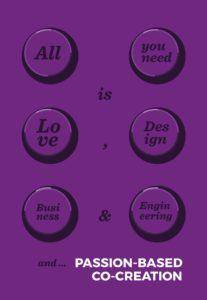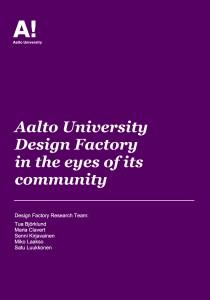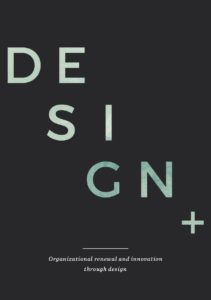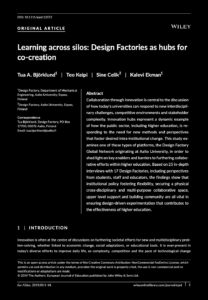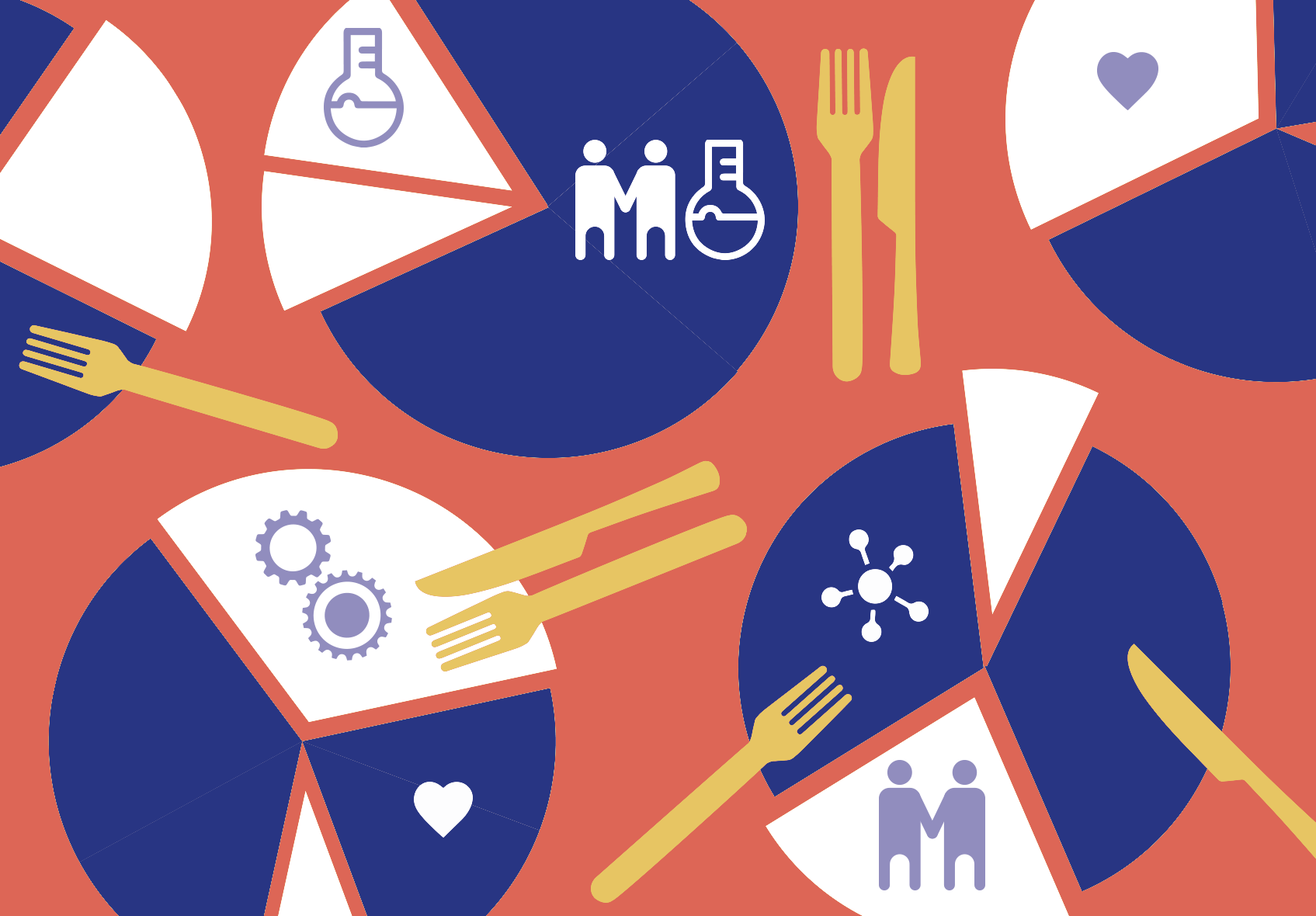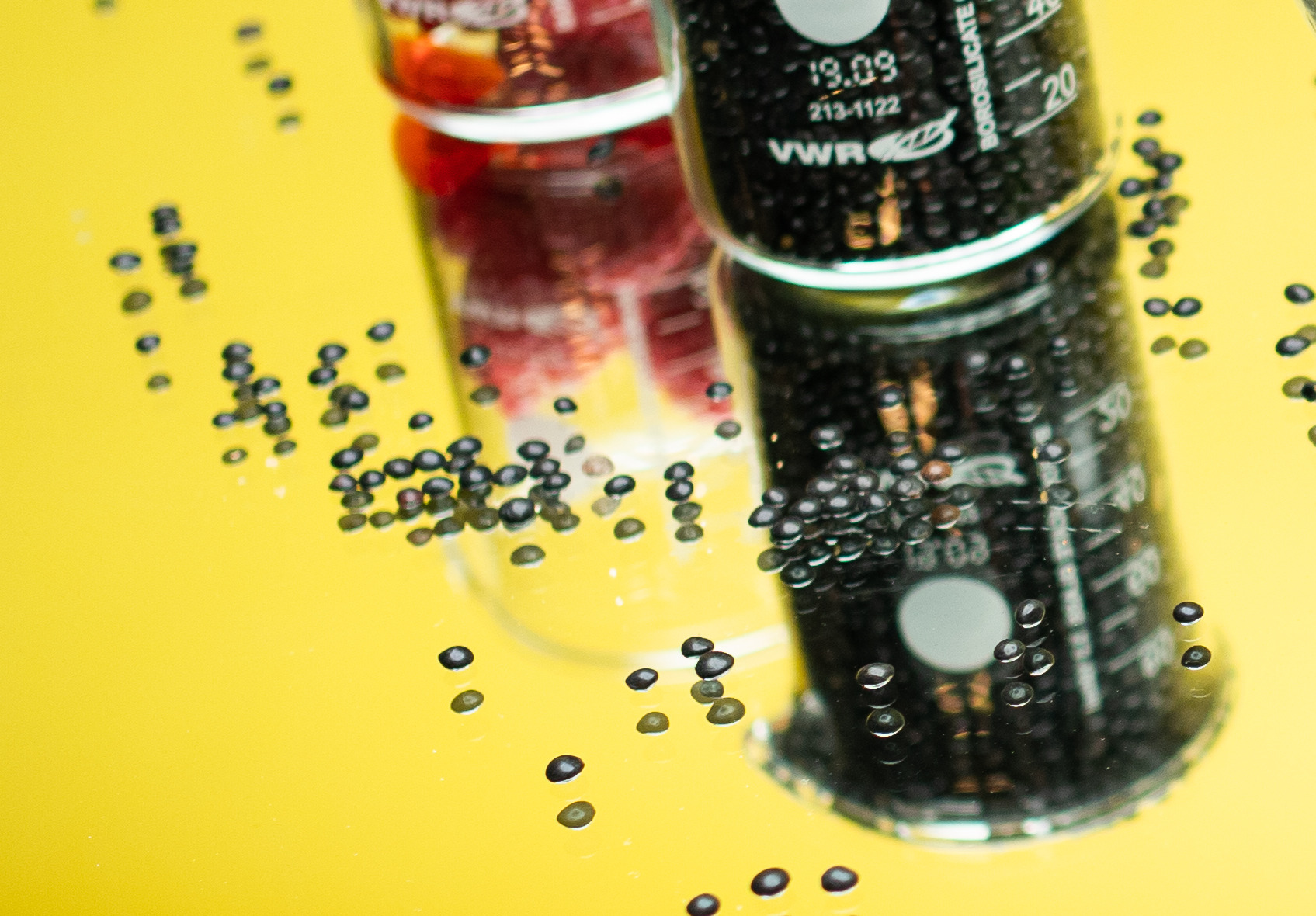Within 72 entrepreneur interviews, 37 DesignBites case companies reported 606 interactions with stakeholders outside of their company when describing their development efforts – we’ve analyzed what these reflect on during-crisis collaboration.
RESEARCH
Design Factory brings together researchers from different disciplines to explore design, development, and innovation from a wide variety of disciplinary perspectives. The in-house researchers represent a variety of fields: cognitive and work psychology, educational sciences, mechanical engineering, management, industrial design etc. All of us work in developing the ADF platform and its practices further in order to both effectively translate research results into practice and ensure the relevance of theoretical endeavors.
ONGOING PROJECTS
PUBLICATIONS
- Björklund, T.A., Gilmartin, S.K. & Sheppard, S. (2023). The dynamics of innovation efforts in the early career. Creativity and Innovation Management, 32, 80-99.
- Feng, X., Ylirisku, S., Kähkönen, E., Niemi, H., & Hölttä-Otto, K. (2023). Multidisciplinary education through faculty members’ conceptualisations of and experiences in engineering education. European Journal of Engineering Education, 1-17.
- Hölttä-Otto, K., Björklund, T.A., Klippert, M., Otto, K., Krause, D., Eckert, C., Nespoli, O. & Albers, A. (2023). Facing extreme uncertainty – how the onset of the COVID-19 pandemic influenced product development. International Journal of Design Creativity and Innovation, 11(2), 117-137.
- Perttunen, E., Keipi, T., Hwang, S., & Björklund, T.A. (2023). Getting by with a little help from my friends: The impact of the pandemic on the collaboration of small Finnish food and beverage ventures. International Journal of Entrepreneurship and Innovation Management, 27(1/2), 51-76.
- Björklund, T.A. & Hannukainen, P. (2022). Tracking design from offerings to strategy. Touchpoint, 13(1), 86-92.
- Deo, S. & Malge, A. (2022). Understanding engineering students’ perceptions of their curiosity, diligence, and perseverance and assessing its impact on their creativity. CERN IdeaSquare Journal of Experimental Innovation, 6(2): 28-40.
- Feng, X. & Björklund, T.A. (2022). Looking beyond your own speciality: student and faculty perceptions of collaboration opportunities. CERN IdeaSquare Journal of Experimental Innovation, 6(2): 20-27
- Figueiredo, S., Ganoo, A., Eriksson, V. & Ekman, K. (2022). Future-ready skills development through Experiential Learning: perceptions from students working in multidisciplinary teams. CERN IdeaSquare Journal of Experimental Innovation, 6(2): 12-19
- Joore, P., Björklund, T.A., Thong, C. & Zancul, E. (2022). Editorial: Co-creating the future through design-based education in innovation hubs. CERN IdeaSquare Journal of Experimental Innovation, 6(2): 1-3.
- Surma-aho, A., Björklund, T.A. & Hölttä-Otto, K. (2022). User and stakeholder perspective taking in novice design teams. Design Science, 8, e24.
- Surma-aho, A., & Hölttä-Otto, K. (2022). Conceptualization and operationalization of empathy in design research. Design Studies, 78.
-
Deo, S., Blej, A., Kirjavainen, S., & Holtta-Otto, K. (2021). Idea Generation Mechanisms: Comparing the influence of classification, combination, building on others, and stimulation mechanisms on ideation effectiveness. Journal of Mechanical Design, 1-46.
-
Li, J., Surma-aho, A., Chang-Arana, Á. M., & Hölttä-Otto, K. (2021). Understanding customers across national cultures: the influence of national cultural differences on designers’ empathic accuracy. Journal of Engineering Design, 1-21.
- Kirjavainen, S., & Hölttä-Otto, K. (2021) Deconstruction of Idea Generation Methods Into a Framework of Creativity Mechanisms. Journal of Mechanical Design, 143(3).
- Björklund, T.A., Mikkonen, M., Mattila, P. & van der Marel, F. (2020). Expanding entrepreneurial solution spaces in times of crisis: Business model experimentation amongst packaged food and beverage ventures. Journal of Business Venturing Insights.
- Björklund, T.A., Keipi, T. & Maula, H. (2020). Crafters, explorers, innovators, and co-creators – Narratives in designers’ identity work. Design Studies, 68, 82-112.
- Björklund, T.A., Maula, H., Soule, S. & Maula, J. (2020). Integrating design into organizations: The coevolution of design capabilities. California Management Review, 62(2), 100-124.
- Chang-Arana, Á. M., Piispanen, M., Himberg, T., Surma-aho, A., Alho, J., Sams, M., & Hölttä-Otto, K. (2020). Empathic accuracy in design: Exploring design outcomes through empathic performance and physiology. Design Science, 6.
- Li, J., & Hölttä-Otto, K. (2020). The Influence of Designers’ Cultural Differences on the Empathic Accuracy of User Understanding. The Design Journal, 23(5), 779-796
- Sheppard, S.D., Björklund, T.A., Chen, H.L., Gilmartin, S.K., Atwood, S., Reynolds Brubaker, E., et al. (2020). Connecting people and ideas: Making sense of a research lab through creating a shared frame. International Journal of Engineering Education, 36(2).
- Surma-Aho, A., Hölttä-Otto, K., Nelskylä, K., & Lindfors, N. C. (2020). Usability issues in the operating room–Towards contextual design guidelines for medical device design. Applied Ergonomics, 90, 103221.
- Song, C., Luo, J., Hölttä-Otto, K., Seering, W., & Otto, K. (2020). Crowdfunding for Design Innovation: Prediction Model With Critical Factors. IEEE Transactions on Engineering Management.
- Björklund, T.A., Keipi, T., Celik, S. & Ekman, K. (2019). Learning across silos: Design Factories as hubs for co‐creation. European Journal of Education, 54(4), 552-565.
- Björklund, T.A. & van der Marel, F. (2019). Meaningful moments at work: Frames evoked by in-house and consultancy designers. The Design Journal, 22(6), 753-774.
- Kähkönen, E. (2019). Is it safe to paint your wall white? A case study on titanium dioxide classification. Integrated Environmental Assessment and Management.
- Tan, S. Y., Hölttä-Otto, K., & Anariba, F. (2019). Development and Implementation of Design-Based Learning Opportunities for Students To Apply Electrochemical Principles in a Designette. Journal of Chemical Education, 96(2), 256-266.
- Kershaw, T.C., Bhowmick, S., Seepersad C.C., & Hölttä-Otto, K. (2018) A Decision Tree Based Methodology for Evaluating Creativity in Engineering Design. Frontiers in Psychology. 10, 32
- Clavert, M., Löfström, E. & Nevgi, A. (2018). Change agency as a way of promoting pedagogical development in academic communities: a longitudinal study. Teaching in Higher Education, 1–18. DOI: 10.1080/13562517.2018.1451321.
- Mendez, AR, Tan, TY, Low, HY, Hölttä-Otto, K, Tan, H, Khoo, X (2018). Micro-textured films for reducing microbial colonization in a clinical setting, Journal of Hospital Infection, January 2018, (98)1, 83–89.
- Hölttä-Otto, K., Otto, K., Song, C., Luo, J., Li, T., Seepersad, C. C., & Seering, W. (2018). The Characteristics of Innovative, Mechanical Products—10 Years Later. Journal of Mechanical Design, 140(8).
- Björklund, T.A. & Krueger, N. (2016). Generating resources through the co-evolvement of entrepreneurs and ecosystems. Journal of Enterprising Communities, 10(4), 477-498.
- Min G.K., Suh, E.S., Hölttä-Otto, K. (2016). System Architecture, Level of Decomposition, and Structural Complexity: Analysis and Observations, Journal of Mechanical Design, 138(2), 021102.
- Min G.K., Suh, E.S., Hölttä-Otto, K. (2016). Impact of technology infusion on system architecture complexity, Journal of Engineering Design.
- Otto, K., Hölttä-Otto, K., Simpson, T.W., Krause, D., Ripperda, S., Moon, S.K., (2016). Global Views on Modular Design Research: Linking Alternative Methods to Support Modular Product Family Concept Development, Journal of Mechanical Design 138 (7), 071101
- Rekonen, S.M. & Björklund, T.A. (2016). Perceived managerial functions in the front-end phase of innovation. International Journal of Managing Projects in Business, 9(2), 414-432.
- Rekonen, S.M. & Björklund, T.A. (2016). Adapting to the changing needs of managing innovative projects. European Journal of Innovation Management, 19(1), 111-132.
- Clavert, M., Löfström, E. & Nevgi, A. (2015). Pedagogically aware academics’ conceptions of change agency in the fields of science and technology. International Journal for Academic Development, 20(3), 252-265.
- Clavert, M. & Paloposki, T. (2015). Implementing Design-Based Learning in Teaching of Combustion and Gasification Technology. International Journal of Engineering Education, 31(4), 1021–1032.
- Clavert, M., Björklund, T.A. & Nevgi, A. (2014). Developing as a teacher in the fields of science and technology. Teaching in Higher Education 19(6), 685-696.
- Laakso, M. & Clavert, M. (2014).Promover la creatividad y las habilidades del pensamiento de diseño entre los estudiantes universitarios (Promoting creativity and design thinking skills among University students). Revista de Estudios de Juventud 104, pp. 215-228.
- Nikander, J., Liikkanen, L. & Laakso, M. (2014). The preference effect in design concept evaluation. Design Studies 35 (5), 473-499.
- Björklund, T.A. (2013). Initial mental representations of design problems: differences between experts and novices. Design Studies 34(2), 135-160.
- Björklund, T.A., Bhatli, D., & Laakso, M. (2013). Understanding idea advancement efforts in innovation through proactive behavior, Journal of Research in Marketing and Entrepreneurship, 15(2), 124-142.
- Björklund, T.A., Nordström, K.M. & Clavert, M. (2013). A Sino-Finnish initiative for experimental teaching practices using the Design Factory pedagogical platform, European Journal of Engineering Education, 38(5), 567-577.
- Clavert, M. & Nevgi, A. (2011). Yliopistopedagogisen koulutuksen merkitys yliopisto-opettajana kehittymisen kokemuksessa. Peda-Forum 11(2), 6-16.
- Björklund, T.A. (2010). Enhancing creative knowledge-work: Challenges and points of leverage. International Journal of Managing Projects in Business, 3(3), 517-525.
- Kirjavainen, S., Björklund, T. A., Eloranta, M.-M. & Laakso, M. (2010). The impact of leadership, management and power in an international knowledge-intensive organization. Cadernos EBAPE.BR, 8(2), 339-352. ISSN 1679-3951.
- Björklund, T.A. (2022). Expedite change. In Valtonen & Nikkinen (eds.): Designing change – new opportunities for organizations (pp. 128-137), Aalto ARTS Books, Joensuu. ISBN 978-952-64-0758-6 / Björklund, T.A. (2022). Vauhdita muutosta. In Valtonen & Nikkinen (toim.): Muotoilulla Muutokseen – Kehitystyön uudet mahdollisuudet (ss. 128-137), Aalto ARTS Books, Joensuu. ISBN 978-952-64-0734-0
- Björklund, T.A. (ed.) (2021). Design + Sustainability 101. Aalto University, Helsinki. ISBN 978-952-64-9606-1.
- DesignBites (2020). From Crisis to Creativity- Entrepreneurial action in Finnish packaged food and beverage products. Aalto University Design Factory.
- Björklund, T.A. & Keipi, T. (eds.) (2019). Design+ Organizational renewal and innovation through design. Aalto University, Helsinki. ISBN 978-952-60-3782-0. 220 p.
- DesignBites (2019). Bite-size insights into Finnish food and beverage ventures. Aalto University Design Factory.
- Clavert, M. (2018). Academics’ transformative learning at the interfaces of pedagogical and discipline-specific communities. Helsinki Studies in Education, number 20. ISBN 978-951-51-3875-0. Unigrafia, Helsinki.
- Björklund, T.A., Laakso M., Kirjavainen, S. & Ekman, K. (eds.) (2017). Passion-based co-creation. Aalto University, Helsinki. ISBN 978-952-60-3740-0. 251 p.
- Björklund, T.A. (2017). Small wins as footholds for co-creation. In Björklund, T.A., Laakso M., Kirjavainen, S. & Ekman, K. (eds.) (2017). Passion-based co-creation. Aalto University, Helsinki. ISBN 978-952-60-3740-0, pp. 80-89.
- Björklund T. (2015). The Dynamics of Proactive Striving – Initiating and sustaining development efforts in product design and entrepreneurship. Aalto University publication series DOCTORAL DISSERTATIONS, 128/2015.
- Laakso, M. & Ekman, K. (editors) (2014). Proceedings of the 10th NordDesign Conference.
- Björklund T., Clavert, M., Kirjavainen, S., Laakso, M. & Luukkonen, S. (2011). Aalto University Design Factory through the eyes of its community. Study report. Aalto University Design Factory, Espoo.
- Hassi, L. & Laakso, M. (2011). Making sense of design thinking. In: Karjalainen, T-M., Koria, M. & Salimäki, M. (eds.): IDBM papers vol 1 (pp. 50-63). Helsinki: IDBM Program, Aalto University. ISBN 978-952-92-8641-6.
- Björklund, T.A. (2009). Challenges in knowledge-intensive creative teamwork. In K. Kähkönen, A. S. Kazi & M. Rekola (toim.): Human Side of Projects in Modern Business (ss.141-150). Helsinki, Finland: Project Management Association Finland (PMAF) in collaboration with VTT Technical Research Centre of Finland. ISBN 978-952-92-5638-9
- Eriksson, V., Keipi, T. & Björklund, T. (2023). Dimensions of proximity in stakeholder choice reflected in the creation of knowledge-based innovation ecosystem partnerships. Proceedings of the Design Society , Volume 3: ICED23, July 2023, 1505 – 1514.
- Kirjavainen,S. & Celik, S. (2023). Environmental considerations in engineering: Systemic differences between experts and novices. Proceedings of the Design Society , Volume 3: ICED23, July 2023, 1655 – 1664.
- Feng, X., & Hölttä-Otto, K. (2022). An Investigation of the Influence of Disciplinary Distance in Interdisciplinary Education Through Faculty’s Experience. In International Design Engineering Technical Conferences and Computers and Information in Engineering Conference (Vol. 85406, p. V004T04A007). American Society of Mechanical Engineers.
- Feng, X., & Hölttä-Otto, K. (2022). An Exploration of Teachers’ Competencies in Interdisciplinary Engineering Education. In International Design Engineering Technical Conferences and Computers and Information in Engineering Conference. American Society of Mechanical Engineers.
- Kirjavainen, S., Vepsäläinen, R., Eriksson, V., & Björklund, T. (2022). Student perceptions of the societal linkages of engineering innovation. American Society for Engineering Education, ASEE 2022 Annual Conference.
- Rekonen, S. & Björklund, T.A. (2022). Championing design thinking practice in an organization driven by engineering. 82nd Annual Meeting of the Academy of Management, 5 August – 9 August 2022.
- Santos Figueiredo, S., Eriksson, V., Björklund, T.A., & Ekman, K. (2022). Mapping design briefs and results over a decade of university-industry student projects. The 24th International Conference on Engineering and Product Design Education.
- van der Marel, F. & Björklund, T.A. (2022). Designers as change agents: Perceived roles in advancing sustainability in organizations on different design utilization levels. Design2022, International Design Conference. Recipient of the Reviewers’ Favorite award.
- Celik, S. & Björklund, T.A. (2021). Social networks as enablers of design cultures, An analysis of multiplex relationships amongst the members of a creative hub. Design Cultures(s) Cumulus Roma 2020.
- Jung, S., Perttunen, E., Kirjavainen, S., Björklund, T. & Kim, S. (2021). Peer designers and strong influences on the design process of food startups. International Conference on Engineering Design, ICED’21.
- Perttunen, E., Jung, S., Kirjavainen, S., Björklund, T, & Kim, S. (2021). The role of consumer influences in the New Product Development of packaged food and beverage ventures. International Conference on Engineering Design, ICED’21.
- Deo, S., Hölttä-Otto, K., & Filz, G. H. (2020, August). Creativity and Engineering Education: Assessing the Impact of a Multidisciplinary Project Course on Engineering Students’ Creativity. In International Design Engineering Technical Conferences
- Chang-Arana, Á. M., Surma-aho, A., Li, J., Yang, M. C., & Hölttä-Otto, K. (2020) Reading the User’s Mind: Designers Show High Accuracy in Inferring Design-Related Thoughts and Feelings. In ASME 2020 International Design Engineering Technical Conferences
- Kirjavainen, S., & Hölttä-Otto, K. (2020) Deconstruction of Idea Generation Methods Into a Framework of Creativity Mechanisms. In ASME 2020 International Design Engineering Technical Conferences
- Castren, K. Celik, S., Björklund, T. Nurmi, N. (2020). Creating value in project-based multidisciplinary design courses. American Society for Engineering Education, ASEE 2020.
- Celik, S., Kirjavainen, S., Björklund, T. (2020).Educating future engineers – student perceptions of the societal linkages of innovation opportunities. American Society for Engineering Education, ASEE 2020. Best paper award.
- Kirjavainen, S., Björklund, T.A., (2019). From invention disclosures to innovation – Challenges in transforming practice. The 22ndInternational Conference on Engineering Design, ICED’19, 15.-20. Delft, The Netherlands, 5th-8thAugust 2019.
- Kirjavainen, S. & Hölttä-Otto, K. (2019) To Classify or Combine: The Effects of Idea Generation Mechanisms on the Novelty and Quantity of Ideas. ASME International Design Engineering Technical Conferences, IDETC2019, August 18-21, 2019, Anaheim CA.
- Kosmala, M., van der Marel, F: & Björklund, T.A. (2019). Interpretations of design thinking across a large organization. The 22ndInternational Conference on Engineering Design, ICED’19, 15.-20. Delft, The Netherlands, 5th-8thAugust 2019.
- Kukko-Liedes, V., Mikkonen, M. & Björklund, T.A. (2019). Experimentation throughout the product development process – lessons from food and beverage ventures. The 22ndInternational Conference on Engineering Design, ICED’19, 15.-20. Delft, The Netherlands, 5th-8thAugust 2019.
- Mattila, P., van der Marel, F. & Mikkonen, M. (2019). Perceived culture of networked knowledge hubs. The 22ndInternational Conference on Engineering Design, ICED’19, 15.-20. Delft, The Netherlands, 5th-8thAugust 2019.
- Raviselvam, S., Karuppasamy, S., Wood, K. & Hölttä-Otto, K. (2019) An extreme user approach to identify latent needs: adaptation and application in medical device design. ASME International Design Engineering Technical Conferences, IDETC2019, August 18-21, 2019, Anaheim CA.
- Sheppard, S.D., Björklund, T.A., Chen, H., et al. (2019). Connecting people, process and output: Making sense of a research lab through creating a shared frame. Clive L. Dym Mudd Design Workshop XI, Claremont, California, USA.
- Simon, P., Björklund, T.A. & Sheppard, S. (2019). Early-career engineers’ perceptions of support for innovation at the workplace – what seems to matter. The 22ndInternational Conference on Engineering Design, ICED’19, 15.-20. Delft, The Netherlands, 5th-8thAugust 2019.
- Surma-aho, A., Chen, C. Hölttä-Otto, K. & Yang. M. (2019) Antecedents and outcomes of designer empathy – a retrospective interview study. ASME International Design Engineering Technical Conferences, IDETC2019, August 18-21, 2019, Anaheim CA.
- Björklund, T.A., Akkola, M. & Maula, H. (2018). Constructing the future of design: How design professionals perceive their changing role. Academic Design Management Conference ADMC18, dmi design management institute.
- Björklund, T.A., Hannukainen, P. & Manninen, T. (2018). Measuring the impact of design, service design and design thinking in organizations on different maturity levels. ServDes 2018, Service Design & Innovation Conference.
- Klenk, M., Björklund, T.A., Gilmartin, S. & Sheppard, S. (2018). Early-career engineers at the workplace: Meaningful highs, lows, and innovative work efforts. ASEE 2018, American Society for Engineering Education.
- Maula, H., Björklund, T.A. & Mikkonen, M. (2018). Artist, explorer or co-creator? A narrative analysis of designers’ career stories. EGOS 2018, European Group for Organizational Studies.
- Mikkonen, M., Tuulos, T. & Björklund, T.A. (2018). Perceived long term value of industry project-based design courses: Alumni reflections from two decades of the Product Development Project. NordDesign 2018.
- Surma-aho, A., Björklund, T.A. & Hölttä-Otto, K. (2018). Assessing the development of empathy and innovation attitudes in a project-based engineering design course. ASEE 2018, American Society for Engineering Education.
- Surma-aho A., Björklund T.A. & Hölttä-Otto K., (2018). An analysis of designer empathy in the early phases of design projects, NordDesign 2018.
- von Unold, B., Böhmer, A.I., Toye, G., Björklund, T.A., & Sheppard, S. (2018). Implications of contextual empathic design for engineering education. ASEE 2018, American Society for Engineering Education.
- Wiggins, C., Arruza Cruz, M., von Unold, B., Björklund, T.A., Gilmartin, S. & Sheppard, S. (2018). Coding for culture, diversity, gender, and identity: the potential for automation in research. ASEE 2018, American Society for Engineering Education.
- Pink, S., Rieken, B., Björklund, T.A. & Sheppard, S. (2017). What makes an inquisitive engineer – An exploration of question-asking self-efficacy and outcome expectations among engineering students. American Society for Engineering Education, Annual conference, Columbus, Ohio.
- Levine, A., Björklund, T.A., Gilmartin, S. & Sheppard, S. (2017). A preliminary exploration of the role of surveys in student reflection and behavior. American Society for Engineering Education, Annual conference, Columbus, Ohio.
- Miranda Mendoza, C., Leal Martinez, D. & Forget, M. (2017). Geographically distributed teams in engineering design: Best practices and issues in cases of international teams working from different continents. American Society for Engineering Education, Annual conference, Columbus, Ohio.
- Hölttä-Otto, K. & Raviselvam, S. (2016). Guidelines for finding lead user like behavior for latent need discovery, NordDesign 2016, August 10-12, Trondheim, Norway.
- Kirjavainen, S., Björklund, T.A. & Laakso, M. (2016). Framing activities and the co-evolvement of products and operations in new ventures, NordDesign 2016, August 10-12, Trondheim, Norway.
- Raviselvam, S., Tam, V., Hölttä-Otto, K. Wood, K. & Nagarajan, K. (2016). A Lead User Approach to Universal Design – Involving elderly in the design process, International Conference on Universal Design (UD2016), August 21-24, York, UK.
- Raviselvam, S., & Hölttä-Otto, K. (2016). User extreme conditions to enhance designer creativity and empathy: Application using visual impairment, ASME IDETC International Conference on Design Education, Charlotte, NC, August 21-24. Paper number: IDETC2016-59602
- Mattila, P. Mäkinen, S.. & Laakso, M. (2014). Facilitating collaboration between individual participants in a university-industry research and development project. Proceedings of the 10th NordDesign Conference.
- Rekonen, S. & Björklund T. (2014). Managerial activities and challenges in the front-end phase of the innovation process. Proceedings of the PMI Research and Education Conference 2014, Portland.
- Clavert, M. (2013). Academics’ conceptions of pedagogical change agency and the challenges of acting as a pedagogical change agent in the fields of science and technology. INTED 2013 (7th International Technology, Education and Development Conference), 4.–6.3.2013
- Clavert, M. & Laakso, M. (2013). Implementing design-based learning in engineering education: Case Aalto University Design Factory. 41th annual SEFI Conference
- Clavert, M., Nevgi, A. & Löfström, E. (2013). What is pedagogical change agency in higher education? 15th Biennial EARLI Conference for Research on Learning and Instruction, “Responsible Teaching and Sustainable Learning”, 27.–31.8.2013, Munich, Germany
- Leisti-Szymczak A., Liikkanen L., Laakso M. & Summanen I. (2013). Let me do my job – Designers’ experiences of collaborating with a client. In Proceedings of the Co-Create 2013 conference
- Nikander, J., Liikkanen, L. & Laakso, M. (2013). Naturally emerging decision criteria in product concept evaluation. In Proceedings of the19th International Conference on Engineering Design, ICED13
- Rekonen, S., Björklund, T.A., Laakso, M. & Likkanen, L.A. (2013). Evolvement of Managerial Activities and Leadership Style of New Product Development Project Managers. 11th IRNOP Conference, IRNOP 2013, Oslo, International Research Network on Organizing Projects.
- Rekonen, S., Björklund, T.A. & Liikkanen, L.A. (2013). The influence of technical expertise on managerial activities throughout the innovation process. The International Conference on Engineering Design.
- Summanen, I., Liikkanen L., Laakso M. and Leisti-Szymczak A. (2013). Co-developing a new technology for product concept testing with remote users. In Proceedings of the Co-Create 2013 conference
- Taajamaa, V., Sjöman, H., Kirjavainen, S., Utriainen, T., Repokari, L., & Salakoski, T. (2013). Dancing with ambiguity design thinking in interdisciplinary engineering education. In Design Management Symposium (TIDMS), 2013 IEEE Tsinghua International (pp. 353-360). IEEE.
- Clavert, M., Nevgi, A., Löfström, E. & Niemi, H. (2012). Defining pedagogical change agency in developing academic communities of practice in higher education. FERA Conference on Education, 22.–23.11.2012
- Laakso, M., & Liikkanen, L. (2012) Dubious role of formal creativity techniques in professional design. In Proceedings of the 2nd International Conference on Design Creativity ICDC2012
- Liikkanen, L. & Laakso M. (2012) Concept design as knowledge construction – the Case of user-centered design. In Proceedings of the 12th International Design Conference DESIGN 2012
- Björklund, T.A. & Laakso, M. (2011). Idea advancement in new product development – a grassroot perspective. 18th International Product Development Management Conference.
- Björklund T.A., Luukkonen, S., Clavert, M., Kirjavainen, S., & Laakso, M. (2011). The role of experimentation in creating and sustaining motivation in design work. Roozenburg, N., Chen L. & Stappers, P. (Ed.) Diversity and unity. Proceedings of IASDR2011, the 4th World Conference on Design Research.
- Hassi, L. & Laakso, M. (2011). Conceptions of design thinking in the management discourse. The 9th International European Academy of Design Conference.
- Hassi, L. & Laakso, M. (2011) Conceptions of design thinking in the design and management discourses – Open questions and possible directions for research. Proceedings of IASDR2011, the 4th World Conference on Design Research
- Hassi, L. & Laakso, M. (2011) Design thinking in the management discourse: Defining the elements of the concept. Proceedings of the 18th International Product Development Management Conference, IPDMC 2011
- Kirjavainen, S. & Björklund, T.A. (2011). The central role of exploration in designing business concepts and strategy. The 18th International Conference on Engineering Design.
- Kirjavainen, S. & Clavert, M. 2011. Manifestation of Design Thinking in Creating a Business Concept and Strategy. Paper presentation at IPDMC 2011 (18th International Product Development Management Conference), 5.-7.6.2011.
- Liikkanen, L., Hämäläinen, M.M., Häggman, A., Björklund, T.A., Koskinen, M.P. (2011). Quantitative evaluation of the effectiveness of idea generation in the wild. In M. Kurosu (Ed.): Human Centered Design, HCII 2011, LNCS 6776, pp. 120–129. Springer, Heidelberg.
- Liikkanen, L., Laakso, M. & Björklund, T.A. (2011) Foundations for Studying Creative Design Practices. 2nd International Conference on Creativity and Innovation in Design, DESIRE’11.
- Luukkonen, S. & Björklund, T.A. (2011). Leadership practice differences at the front end and development phases of innovation process. 27th EGOS Colloquium, July 6-9, 2011, Gothenburg.
- Björklund, T.A., Laakso, M. & Eloranta, M.-M. (2010). Innovations and the ability to advance ideas: Antecedents and practices of advancement. 3rd Latin American and European Meeting on Organization Studies.
- Kirjavainen, S., Björklund, T.A., Eloranta, M.-M. & Laakso, M. (2010). The impact of leadership, management and power in an international knowledge-intensive organization. 3rd Latin American and European Meeting on Organization Studies.
- Laakso, M. & Björklund, T.A. (2010). Issues in the operations improvement of European-Latin American innovation projects. 3rd Latin American and European Meeting on Organization Studies.
- Björklund, T. A. & Eloranta, M.-M. (2009). Adapting knowledge: Interaction between education and working life. In Proceedings of INTED2009 Conference, pp. 2138-2148. International Association of Technology, Education and Development (IATED): Valencia, Spain. ISBN 978-84-612-7578-6.
- Hämäläinen, M. M. & Laakso, M. (2009). Participative, employee-driven method for knowledge-harvesting in university-industry collaboration – A Case Example from Finnish Industry,” Proceedings of the INTED2009 Conference
- Laakso, M., Hämäläinen, M.M. & Häggman, A. (2009). Improving Lead organization and supplier interaction – A case study” 2009 In Proceedings of the ICSB World Conference
- Laakso M., Ukkonen, M., Forsblom, J., Häggman, A. & Hämäläinen, M.M. (2009). SME operations development – Empirical observations of allocating improvement activities on the basis of cost-effect estimations. 6th Annual International Conference on Small and Medium Sized Enterprises
- Liikkanen, L.A., Björklund, T.A., Hämäläinen, M. & Koskinen, M. (2009). Time constraints in design idea generation. International Conference on Engineering Design 24-27 August 2009 / Stanford, USA. (9)81-89.
RESEARCH PERSPECTIVES
-
Learnings from collaboration in times of calm & crisis
-
Experimenting during the pandemic
Anna Kuukka 16/12/2021Experimenting during the pandemicCREATIVE RESPONSES OF FINNISH FOOD VENTURES AMIDST THE CRISIS
Based on interviews from 24 Finnish food ventures and 844 Covid-19 related Instagram posts in March-May 2020 from 66 Finnish food ventures, we found that many companies were active experimenters right away when the pandemic hit. While the social media posts consisted mostly of communications and marketing content, 152 posts from 40 ventures showcased new products, services, sales channels and actions. The 24 interviews revealed 86 further experiments, in all arenas of the companies’ business models.
The entrepreneurs described the crisis lowering the threshold for experimentation through need to compensate for lost revenue, sense of urgency or simply more time to experiment due to the cancelled events and commitments. Furthermore, many of the experiments would result in new skills, relationships and build brand recognition through increased publicity. Some would even end up becoming permanent additions to the solutions portfolio of the ventures.
“The hand sanitizer is still a part of our product portfolio and probably will be also in the future. […] However, compared to now, it probably will be more important in the hotels, restaurants and catering sector than in the retail stores.”
– Mikko Mykkänen / Helsinki Distilling Company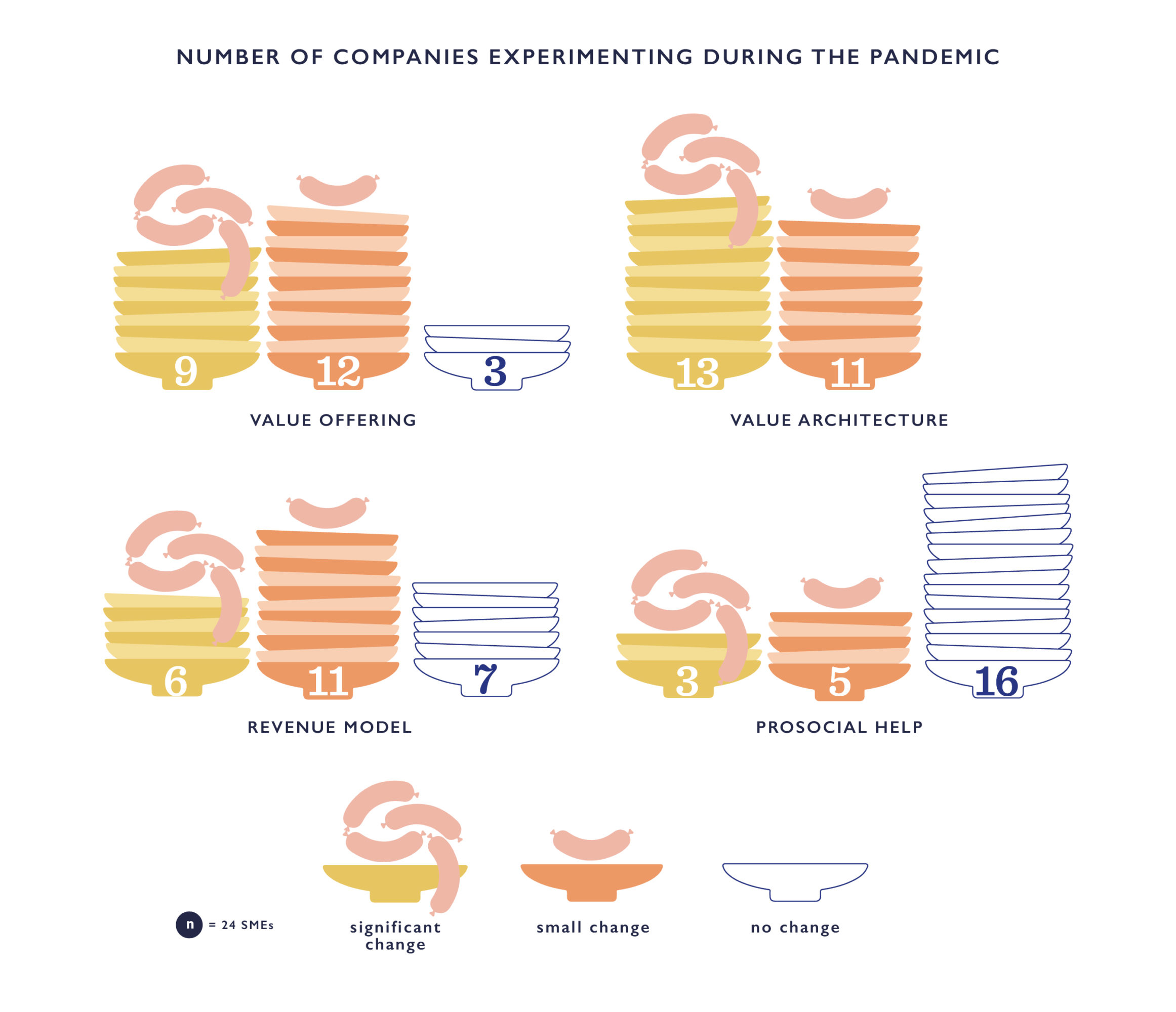
ACTIONS IN THE BACKSTAGE – NEW WAYS OF CREATING VALUE AND REVENUE
Experiments with the value creation architecture or revenue model were not necessarily visible to the outside eye but were prevalent with the ventures. All interviewed ventures had tried out some changes in their core competences and resources, pulling from example employees hobby skills or leveraging the pandemic to initiate remote collaboration. Some made also changes to their production process, increasing hygiene standards or streamlining processes. Trying out new solutions in capabilities, production and partnerships were often sparked by the desire to launch new offerings, but also functioned in the opposite direction of entrepreneurs finding creative new uses for the resources at hand.
Experiments in distribution processes and partners were mostly incremental, whereas experiments in internal value creation processes included more radical shifts from pre-crisis operations. For example, Arctic Kombucha had to transfer its business focus from the initially planned restaurant sector to consumers, basically rebuilding its whole value creation process. For Palms & Berries, the pandemic acted to speed up experimentation towards a subscription model.
BUNDLING PRODUCTS AND EXPERIMENTING WITH NEW TYPES OF OFFERING
Most of the experiments done by the food ventures were product-related. In addition to more incremental changes such as modifying existing products or bundling products together, many ventures would introduce new products or even enter completely new product categories. Examples of radical changes in product portfolios included Kyrö Distillery and Helsinki Distilling Company both entering the market of hand sanitizers. Also, Helsieni introduced new non-food products of mushrooming knives. Collaborative product experiments like collaborative bundles or co-created products were almost as frequent as experiments done within the companies. For example, Mettä Nordic and Sugar Daddies joined their forces to create an immunity boosting product package, and Kaffa Roastery bundled up its coffees with sweets and treats from other local food ventures.
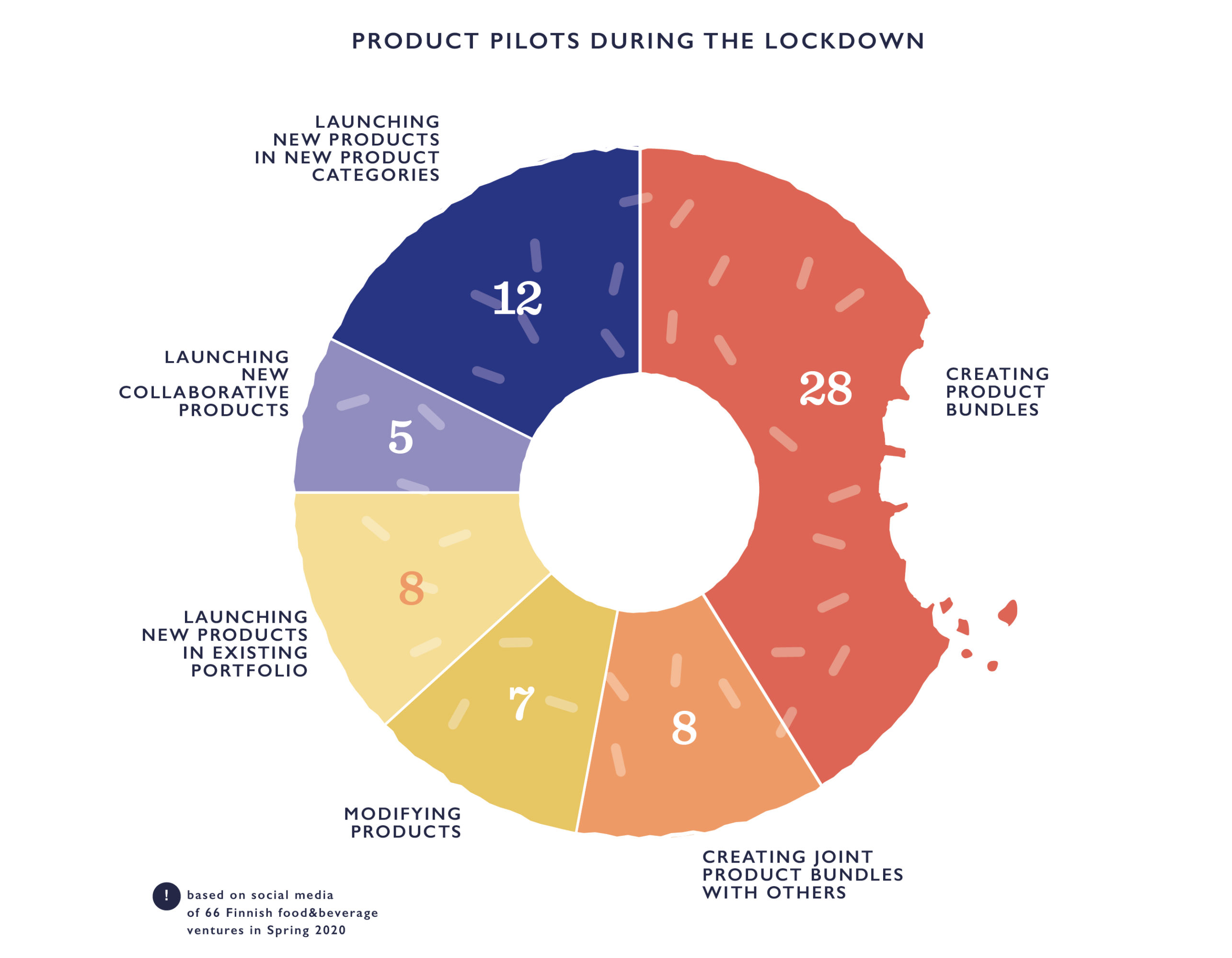
GOING ONLINE AND TO HOME DOORS
In addition to products, many experimented with new services, often online. For example, Warrior Coffee launched a virtual coffee break and Mö Foods moved the launch of its oat-based drinks online. Many also tried out new delivery services, with for example Baba Foods bundling up products originally meant for business-to-business sales and delivering these to customers’ homes, and frozen-dough company Caccu delivering freshly baked cookies to its customers every Friday during the first few months of the pandemic.
EXPERIMENTING WITH NEW SALES CHANNELS
The closing of restaurants, cafes and bars, as well as restrictions in in-person meetings, resulted in cancelled events and sales, driving companies to experiment with sales channels. These experiments included launching webstores, establishing new physical sales points, such as kiosks and windows on the walls, as well as collaborating with other to expand distribution. For example, Helsinki Distilling Company opened a corona kiosk in front of its production facility where it would sell its hand sanitizers, long drinks and masks from a partner, and Espoon Oma Panimo introduced a beer delivery truck that would drive around Espoo to reach homebound customers. Knehtilän Pieni Puro, on the other hand, added both lifestyle brand Minska and food hub Uudenmaan Ruoka as new sales channels.
“During the same week as the lockdown was issued at least all the companies in within our network started to build online stores. Everyone was exchanging messages in a Whatsapp group and comparing which is the best platform and so on. So we were all in the same situation, and it has been really active and sort of small circles, and good collaboration amongst us.”
– Topi Kairenius / Fat Lizard BreweryEXPERIMENTING BEYOND BUSINESS MODELS
Not all experimentation was directed towards creating revenue or brand visibility. The 9 identified prosocial experiments ranged from helping out critical and at-risk groups, such as donating products to health care professionals, to supporting fellow entrepreneurs. For example, Caccu would, inspired by an idea from one of its customers, deliver freshly baked cookies to the Meilahti Hospital staff treating corona patients. They got the inspiration when some people participating in their cookie delivery raffle suggested they’d donate the prize if they won – the founder loved the idea, got in touch with the corona department of Meilahti hospital and set up the delivery.
Many ventures also took part in the #supportyourlocal movement. Beyond social media, ventures joined forces to simultaneously help themselves as well as their communities. For example, Record Coffee supported struggling restaurants and cafes through its #coffeeaid campaign. The crisis could give both ventures and their customers a pause to think about how they wanted to use their energy and resources.
“We have been thinking about different possibilities to help others. Perhaps through that synergy, we started and are bringing out a pollinator guide and seed bag, so we could bring a little more community-feel to people, and at the same time use the fact that people are reachable now and thought about things they would like to do.”
– Ville Rinta / Sugar Daddies Honey Co.BEYOND THE PANDEMIC: KEEPING UP THE SPIRIT OF EXPERIMENTATION
Although, action lies in the heart of entrepreneurships even beyond times of crisis, the Covid-19 pandemic acted as a catalyst for many food entrepreneurs to step up to experiment, innovate, co-create and generate a positive impact on the food ecosystem. The entrepreneurs not only expanded their offering with new products and services created either in-house or collaboratively, but also transformed their whole business models and increased their capabilities for subsequent value creation and experimentation. Time will yet show the eventual effects of the experiments done amidst the crisis, but it is for sure that you will learn more from action rather than inaction.
You don’t have to wait for the next crisis to give you “permission to hustle” but can start experimenting already today with the tools and tips in our experimentation toolkit!
Full post -
The food industry at large
Anna Kuukka 16/12/2021The food industry at largeINGREDIENTS OF THE FINNISH FOOD INDUSTRY
Interviewing 16 different types of food industry players, including suppliers, investors, cafes, restaurants, and retail chains, draws a picture of an industry with long traditions yet undergoing large transformation resulting from innovations in how we design, produce, choose, deliver and enjoy food. The industry players brought up a large variety of both challenges and rising opportunities, with four common themes emerging.

CHALLENGES IN BRANDINGMany stakeholders in the food industry saw that the companies were failing with the marketing and selling of their products. Marketing was seen to lack a clear and compelling focus, and often cut corners. While the number of encouraging examples like Kyrö Distilling Company and 3 Kaveria ice cream was seen to be on the rise, many felt than most Finnish food companies had not yet managed to build brands that would truly speak to the customers.
“We have never understood the importance of unique, long-term and inimitable brands. That is our biggest challenge. No crop anywhere in the world, except north of Helsinki, get as many hours in the sun between the months of June to August than in Finland.”
– Jyrki SukulaLess mentioned challenges included a lack of financing and recourses, as well as strict regulation and legislation that could slow down development.
COLLABORATION ACROSS THE INDUSTRYA lack of communication and connection between industry players from different fields and of different sizes was seen as another common challenge. With better collaboration, stakeholders could complement each other to help novelties all the way to the grocery aisles, such as large companies having better resources and small companies offering many food innovations.
“If we compare our startup ecosystem to let’s say California, they have more foodtech-focused startups. And surprisingly, many of them are located within close proximity to one another. In Berkeley, there is this one block where a bunch of them are located. So, many of the world’s top foodtech startups are based in the same block. They are constantly going to eat lunch together, sharing their experience, lending their resources. Here in Finland, we live more dispersed, but in the same way as in the States, we should be able to build close relationships between the foodtech players.”
– Lauri Reuter / Nordic Food Tech VCYet, many interviewees reported that recent years have seen rapid and even disruptive changes within the food ecosystem, as new players have emerged, and old ones have shifted their roles. Especially startups were seen as flexible changemakers, forcing established players to reinvent themselves as well. Increased interconnectedness across the ecosystem has been a fertile ground to build new collaborations on.
SCALABLE SUSTAINABILITYIndustry-wide collaboration was called for to advance environmental and sustainability issues. There was a clear call for the industry to focus on quality over quantity to minimize food waste. Environmental issues were seen to concern the whole food supply chain, from the ways we grow our food to the material we package it in. Concerns ranged from ensuring the security of food supply and the viability of food producers without ruining the environment, to the future outlook of two of our significant industries, meat and dairy.
Despite, or maybe because of, sustainability is a serious challenge for the food industry, many positive recent developments within the food industry have tackled sustainability challenges or, at least, increased awareness about the urgency of the issues. The safety of the Finnish food due to trustworthy processes and surveillance was listed as a core strength of the Finnish food ecosystem and was seen as beneficial for new sustainable innovations. The growing number of vegan and vegetarian products was highlighted as one example of increased sustainability and health awareness. In the future, these product categories were seen to only increase more. For example, vegan craft chocolatiers reflected that sustainability and business go hand in hand for them.
“Of course, if our sales increase, we have more resources at hand to create an impact. Therefore, the more we sell, the wider impact we’re able to create.”
– Jukka Peltola / Goodio
NEW THINGS COOKINGNew innovations by food ventures were seen as a key opportunity and increasing ability of the Finnish food industry. Gold & Green with their Nyhtökaura, Pouttu with their Muu product range and Solar Foods with their protein derived out of air were frequently mentioned as examples of promising recent innovations by Finnish food companies. Although startups were seen to be at the forefront of disrupting the industry with their novel foods, also larger and more established players were seen to have woken up to the need to renew themselves and have added fire to their flames of innovation.
CONTACT
-
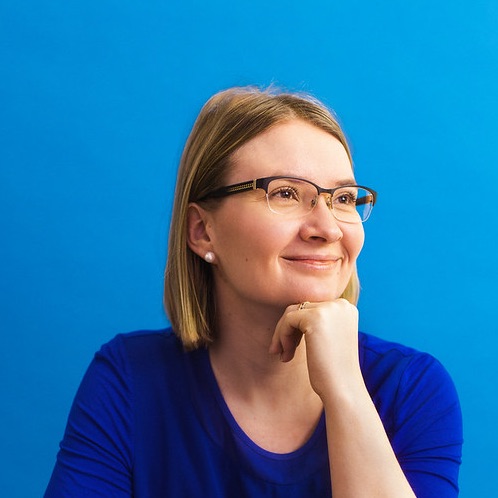
Tua Björklund DF Co-Director, Assistant Professor
tua.bjorklund@aalto.fi
+358 50 511 3182 -

Maria Svanström Aalto Co-Educator
maria.svanstrom@aalto.fi +358503255735
-

Vikki Eriksson Head of Research
vikki.eriksson@aalto.fi
+358 50 466 8713 -
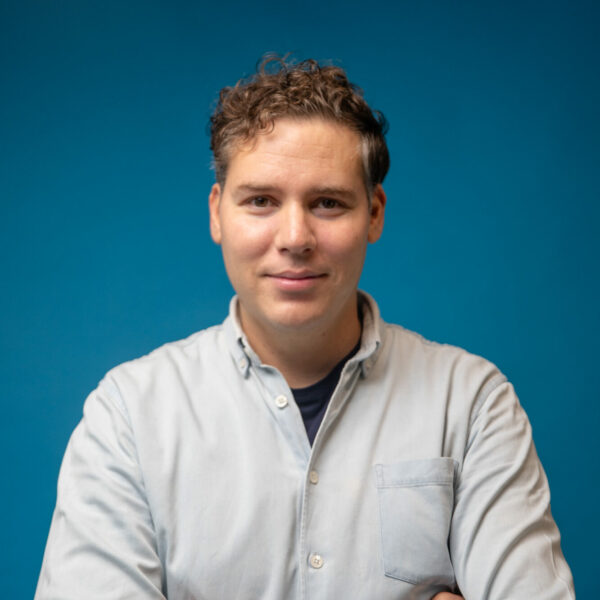
Teo Keipi Postdoc researcher
teo.keipi@aalto.fi
+358 50 476 3733 -

Floris van der Marel Researcher
floris.vandermarel@aalto.fi
N/A -

Senni Kirjavainen Researcher
senni.kirjavainen@aalto.fi
+358 50 521 5964 -

Sara Santos Figueiredo DFGN strategy coordinator
sara.santosfigueiredo@aalto.fi
+358 50 592 7107
 Aalto DF
Aalto DF